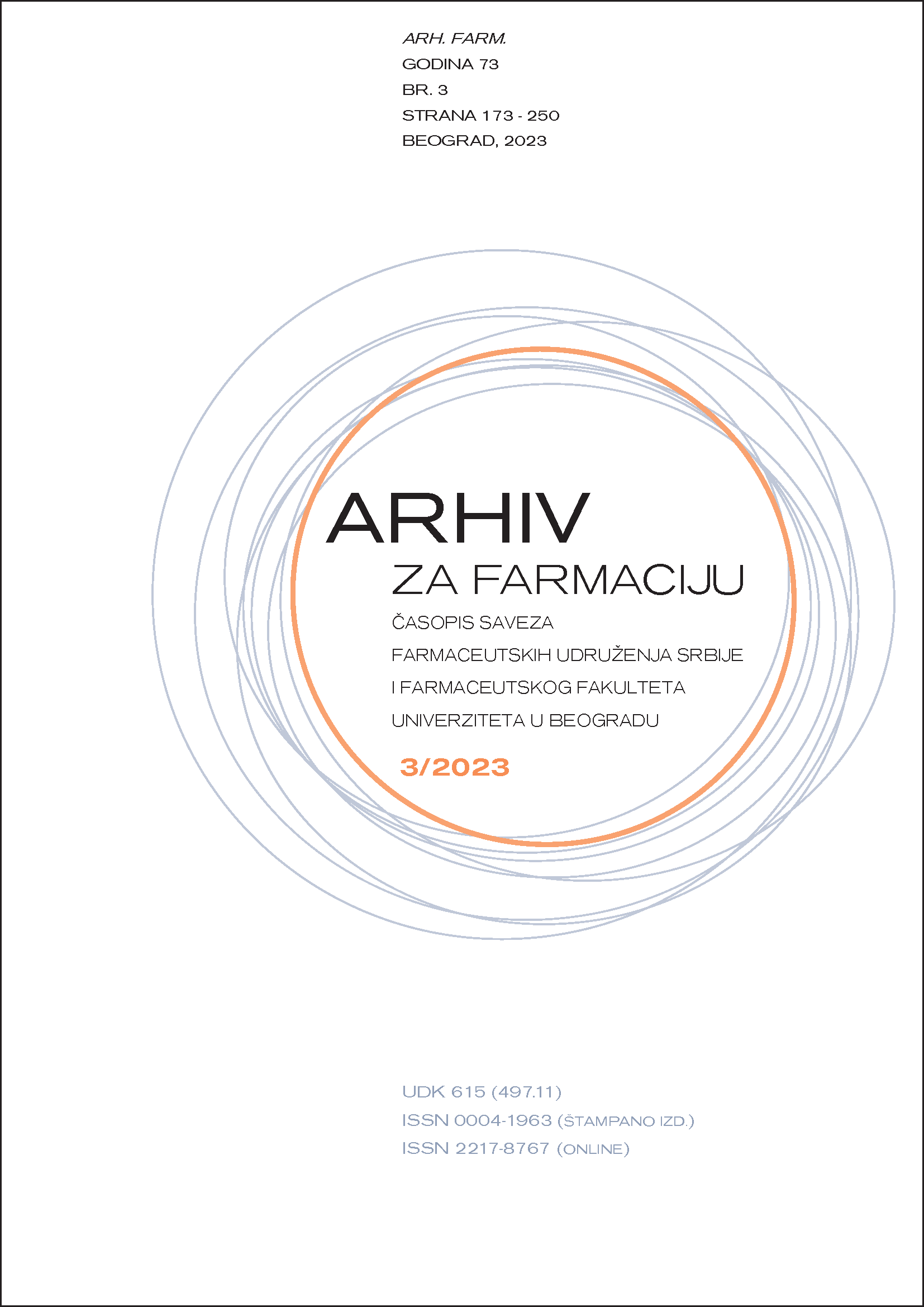Docking studies of some pyrazole containing compounds in the cyclooxygenase-2 active site
Abstract
Whereas nonselective nonsteroidal anti-inflammatory drugs, such as aspirin, ibuprofen and diclofenac, inhibit both cyclooxygenase-1 and cyclooxigenase-2 enzymes, selective inhibitors target cyclooxygenase-2, which is overexpressed in inflammation, but also in cancer, atherosclerosis, Alzheimer's disease, and Parkinson`s disease. Potential cardiovascular and hepatic side effects of cyclooxygenase-2 inhibitors have limited their use. The development of selective and safe cyclooxygenase-2 inhibitors remains a high priority in drug discovery. Based on the structure of previously investigated newly synthesized β-hydroxy-β-arylpropanoic acids, two groups of compounds were designed: analogs in which one of the benzene rings was replaced by a pyrazole, while the carboxyl group was retained, and amides of β-hydroxy-β-arylpropanoic acids with pyrazole. The compounds were docked into the 3D structure of the catalytic site of the enzyme cyclooxygenase-2 using AutoDock Vina 1.2.0. and the obtained interactions were compared with the interactions of celecoxib, a selective inhibitor. The amides had lower binding energies than the designed acids, which makes them attractive target compounds for synthesis and further examination.
References
1. Ahmed AU. An overview of inflammation: mechanism and consequences. Front Biol. 2011;6(4):274-81.
2. Tsalamandris S, Antonopoulos AS, Oikonomou E, Papamikroulis GA, Vogiatzi G, Papaioannou S, et al. The role of inflammation in diabetes: current concepts and future perspectives. Eur Cardiol. 2019;14(1):50-9.
3. Tansey MG, Wallings RL, Houser MC, Herrick MK, Keating C, Joers V. Inflammation and immune dysfunction in Parkinson`s disease. Nat Rev Immunol. 2022;22(11): 657-73.
4. Kinney JW, Bemiller SM, Murtishaw AS, Leisgang AM, Salazar AM, Lamb BT. Inflammation as a central mechanism in Alzheimer's disease. Alzheimers Dement: Transl Res Clin Interv. 2018;4:575-90.
5. Moriya J. Critical roles of inflammation in atherosclerosis. J Cardiol. 2019;73(1):22-7.
6. Zhao H, Wu L, Yan G. Chen Y, Zhou M, Wu Y, et al. Inflammation and tumor progression: signaling pathways and targeted intervention. Sig Transduct Target Ther. 2021;6:263-309.
7. Deshmukh SK, Srivastava SK, Poosarla T, Dyess DL, Holliday NP, Singh AP, et al. Inflammation, immunosuppressive microenvironment and breast cancer: opportunities for cancer prevention and therapy. Ann Transl Med. 2019;7(20):593-607.
8. Lim B, Woodward WA, Wang X, Reuben JM, Ueno NT. Inflammatory breast cancer biology: the tumour microenvironment is key. Nat Rev Cancer. 2018; 18(8):485-99.
9. Janakiram NB, Rao CV. The role of inflammation in colon cancer. Adv Exp Med Biol. 2014;816:25-52.
10. Wang D, DuBois RN. The role of anti-inflammatory drugs in colorectal cancer. Annu Rev Med. 2013;14(64):131-44.
11. Vane JR, Bakhle YS, Botting RM. Cyclooxygenases 1 and 2. Annu Rev Pharmacol Toxicol. 1998;38(1):97-120.
12. Roche VF, Williams DA, Lemke TL, Zito SW. Foye's Principles of Medicinal Chemistry. 8th ed. Philadelphia: Lippincott Williams & Wilkins; 2019.
13. Capone ML, Tacconelli S, Sciulli MG, Patrignani P. Clinical pharmacology of selective COX-2 inhibitors. Int J Immunopathol Pharmacol. 2003;16(2 Suppl):49-58.
14. Guedes IA, de Magalhães CS, Dardenne LE. Receptor–ligand molecular docking. Biophys Rev. 2014;6:75-87.
15. Jakhar R, Dangi M, Khichi A, Chhillar AK. Relevance of molecular docking studies in drug designing. Curr Bioinform. 2020;15(4):270-8.
16. Ferreira LG, Santos dos RN, Oliva G, Andricopulo A. Molecular docking and structure-based drug design strategies. Molecules. 2015;20:13384-421.
17. Savić J, Dilber S, Marković B, Milenković M, Vladimirov S, Juranić I. Docking studies and α-substitution effects on the anti-inflammatory activity of β-hydroxy-β-arylpropanoic acids. Molecules. 2011;16(8):6645-55.
18. Savić J, Dilber S, Milenković M, Kotur-Stevuljević J, Marković B, Vladimirov S, Brborić J. Docking studies, synthesis and biological evaluation of β-aryl-β-hydroxy propanoic acids for anti-inflammatory activity. Med Chem. 2017;13(2): 186-96.
19. Eberhardt J, Santos-Martins D, Tillack AF. Forli S. AutoDock Vina 1.2.0: New docking methods, expanded force field, and python bindings. J Chem Inform Model. 2021;61(8):3891-8.
20. Trott O, Olson, AJ. AutoDock Vina: improving the speed and accuracy of docking with a new scoring function, efficient optimization, and multithreading. J Comp Chem. 210;31(2):455-61.
21. The PyMOL Molecular Graphics System. Version 2.0. Schrödinger, LLC.
22. ChemOffice Version 7.0 ultra. Cambridge Soft Corporation, Software Publishers Association, 1730 M Street, NW, Suite 700, Washington D.C.20036 (2002), 452–1600 USA.
23. Brune K, Hinz B. Selective cyclooxygenase‐2 inhibitors: similarities and differences. Scand. J Rheumatol. 2004;33(1):1-6.
24. Kurumbail RG, Stevens AM, Gierse JK, McDonald JJ, Stegeman RA, Gildehaus D et al. Structural basis for selective inhibition of cyclooxygenase-2 by anti-inflammatory agents. Nature. 1996;384:644-48.
25. Correa CM, de Paula AF, da Silva GM, Sant'Anna CM, Fraga CA, Barreiro EJ. The molecular basis of COX-2 versus COX-1 selectivity of lumiracoxib by molecular docking studies. Lett Drug Des Discov. 2007;4(6):422-5.
26. Buvanendran A, Barkin R. Lumiracoxib. Drug Today. 2007;43(3):137-47.

